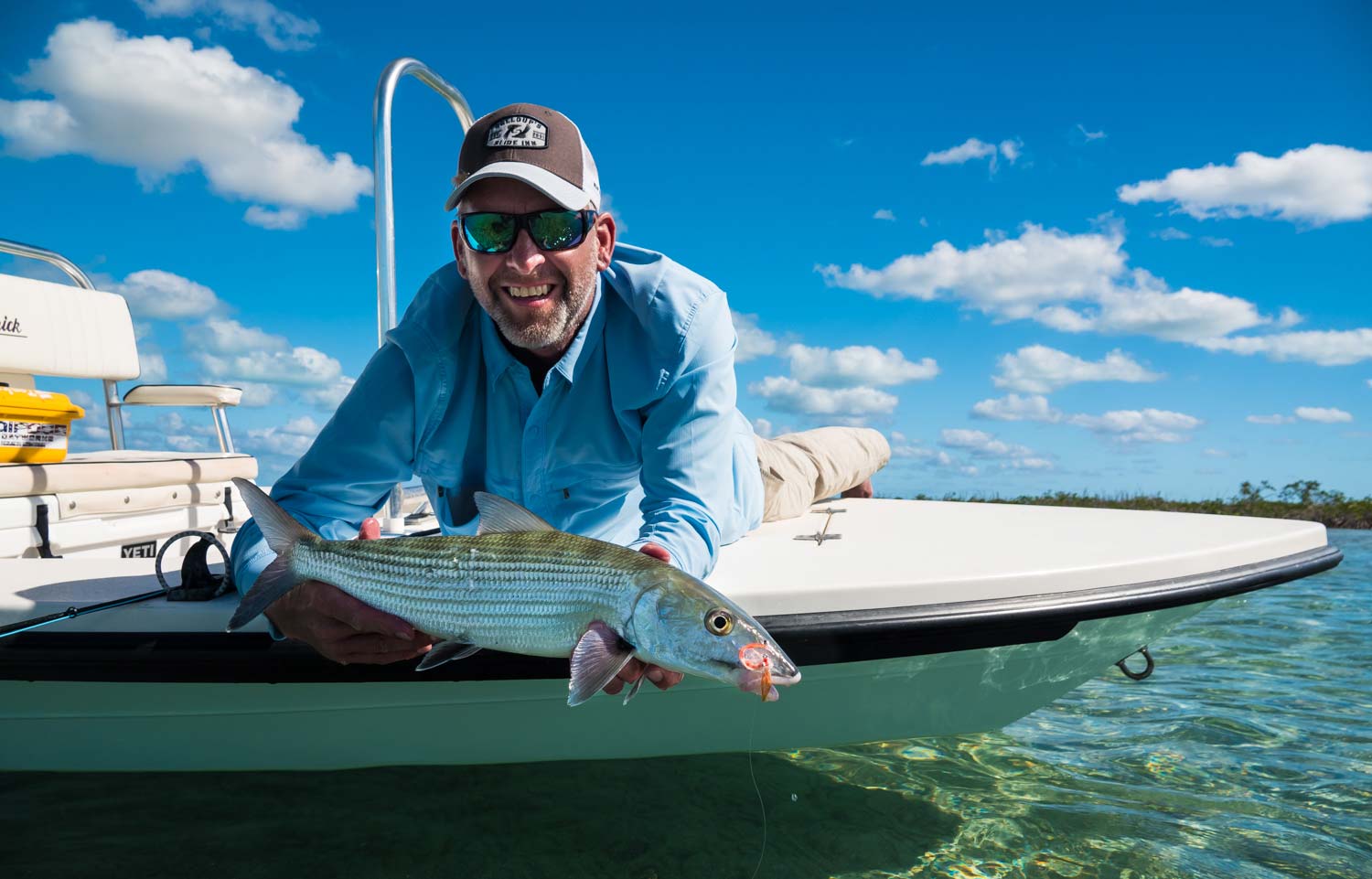
Mark Wilson gets initiated. Photo by Louis Cahill
by John Byron
You’re giving thought to going on your first bonefish expedition, but you want more information.
You’re in luck — there’s a ton of great advice out there from true experts.
But much of that super info is geared to someone already in the game who wants to do better.
Let me approach the topic from the opposite direction, that of the true beginner, which I was four years ago and largely still am.
In a previous blog posting here, I gave you a flats-level view of the subject in A Beginner’s Guide to Catching Bonefish.
Here’s my take on the topic at Angels Twenty, the picture seen from 20,000 feet: what are the true basics for someone considering their first bonefish adventure?

Art by Debbie Tweedy
Destination: The first question is where to go.
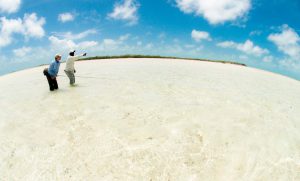 The Bahamas are the most accessible for most people.
The Bahamas are the most accessible for most people.
- Which island to go to deserves research, but they all provide pretty good fishing.
- The Keys and Hawaii have big fish, but it’s advanced-level fishing and not good for a first-timer.
- Belize has lots and lots of fish, but they tend to run a bit smaller than other places.
- More exotic destinations — e.g., Christmas Island; the Seychelles — are great fishing, but they’re pretty daunting as a starting place.
- Ease of travel will enter into your considerations.
When: What time of year.
- As always, the best time to go fishing is when you can.
- But you have to consider the hurricane season; it’s a crapshoot, plus many operations close then.
- And a cold front in winter can affect the fishing in the more northern Bahamas destinations (though with bigger fish in the offing too).
Accommodations: Gotta eat and sleep somewhere.
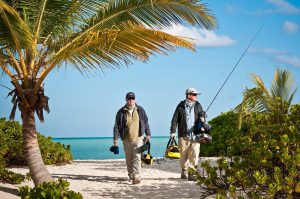 Easiest access to the sport is a hosted “bonefish school.”
Easiest access to the sport is a hosted “bonefish school.”
- Gink & Gasoline; Orvis.
- All arrangements made except travel to/from.
- Expert help from the host and from guides geared to those new to the sport.
- Nice chow, sleeping, amenities.
- Next easiest is a trip put together by one of the outfits that packages fishing trips.
- Nervous Waters, Deneki, H2O Bonefishing, The Fly Shop, Yellow Dog, others.
- Most difficult is the do-it-yourself trip.
- Attractive if you’re pinching pennies.
- But odds of getting skunked and frustrated as a newcomer are pretty high.
Trip Duration: How much time will your first trip for bonefish take?
- The number of days on the water correlates directly with the cost of the trip.
- Plus at least one day each way to get to the fishing; more for some places with overnight stays to make the flights work.
- The longer the trip, the better the odds of not getting weathered out.
- Four to six days on the water would be a nice first trip.
Cost: The dollar side of a bonefish trip.
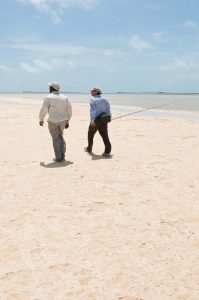 Lodge cost is the big-ticket item. All are upfront about rates.
Lodge cost is the big-ticket item. All are upfront about rates.- Travel expense has to be added in.
- Ditto tips, both daily guide tips (figure $100 per day per boat) and the lodge tip at end of stay, perhaps another one to two hundred bucks.
- And the tackle you’ll need ain’t cheap … the typical guy or gal out there on the flats chasing bonefish is worth around $2000 on the hoof
- Though you can get by for less, borrow/rent tackle at the destination, bum the gear for this first trial trip from a buddy, etc.
- Baseline starting point to estimate the cost for a typical trip? — the gear plus $5000.
Knowledge: You’re spending all this money and time. What should you learn in advance to protect your investment?
- You need to understand the fish, the fishery, and the waters.
- Google and YouTube are your friends.
- Orvis, Gink & Gasoline, and Deneki have a ton of great blog postings in their archives.
- Two stupendous books, both with the same title: Fly Fishing for Bonefish. By Dick Brown. And by Chico Fernandez.
- Google Earth shows the geography.
Skills and Abilities: How good do you have to be to chase bonefish?
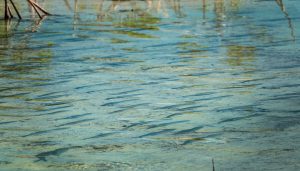 Biggest foot-stomper: Beginners Catch Fish!
Biggest foot-stomper: Beginners Catch Fish!
- An even-money bet on whether you’ll catch a bonefish on your first day is a sucker bet. Take it on the will catch fish side.
- But you have to be able to handle an 8-weight out to at least 40 feet.
- In a stiff breeze.
- Using good line speed and the double-haul.
- And also get a fly in front of the fish that pops up ten feet from the boat (sometimes the toughest shot).
- And this is not a sedentary sport. Be prepared for eight hours a day…
- Bouncing around a lot in a flats boat getting to the fishing.
- And wading the flats in bottom that can get soft and lumpy.
- The rest of it you’ll start to pick up on your first trip.
- And add to every time after that you go out. Fishing is learning. That’s why it’s so much fun.
Gear: What to bring.
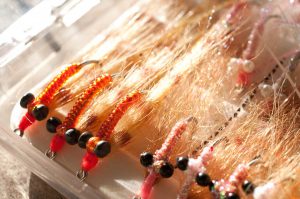 A saltwater 8-weight outfit.
A saltwater 8-weight outfit.
- And a backup is useful, perhaps another 8-weight in case you break one or a 9-weight for winds or a 7-weight for ultra-calm conditions.
- But most operations have decent outfits to rent or borrow, so that’s a startup option too.
- A good set of bonefish flies.
- No need to go nuts on this. A couple dozen flies in basic bonefish patterns will do just fine.
- The better lodges normally have flies for sale.
- Checklists abound online for all the other essentials and niceties you’ll want to have with you. Use them.
- Don’t Get Sunburned!
Personal Virtues: Mental preparation is part of the planning. You’ll need…
- Patience:
- Be ready to take the conditions you find: wind, dark skies, cold fronts, rain, slow days, buck fever.
- Tom Brokaw says this is more hunting than fishing and he’s right.
- Intensity:
- This is extremely demanding fishing. Accessible, yes. Some days easy. But always ready to kick your ass.
- Humility:
- Nobody handles every good shot well.
- And the not-so-good-shots are even tougher.
- Even the experts blow shots more often than they want to admit.
- Again: this is really challenging fishing.
Why Do It?: If it’s this tough, why go to all the expense in time and money and then risk self-humiliation and severe depression?
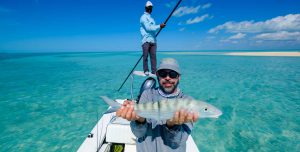 Because it is so challenging.
Because it is so challenging.- It’s incredible sport.
- It’s fantastic fun.
- For many, it’s the culmination of a lifetime of fly fishing.
- The late Lefty Kreh said that bonefish were the one fish he’d go after if he could only go after one.
- Welcome to a grand self-nominating society that brings out the best in those who join.
Responsibilities: What ethical burdens do you take on if you take up bonefishing?
- You have obligations:
- Protect the fish you catch.
- Protect the waters they swim in.
- Fish to a high ethical standard — you’ll know when you do.
- Dammit, have fun. It’s why you’re out there.
- Join the Bonefish and Tarpon Trust to advance the science and preserve the sport for future generations.
John Byron
John Byron lives in Cocoa Beach FL. He’s been fly fishing since he was ten.
Gink & Gasoline www.ginkandgasoline.com hookups@ginkandgasoline.com Sign Up For Our Weekly Newsletter!
A good article. I have a priced packing list for each of my destinations as the gear and requirements are different. I do mine in a spread sheet. Sheet one is the priced packing sheet. This is linked to sheet 2 which is my Insurance Claim sheet in the event of my baggage being lost in transit. It is surprising how quick the response is when the person on the counter sees the size of the dollars being claimed for six outfits and spares plus flies and all of the other gear. A copy of the list goes to the person who is my contact at home and my “In Case Of Accident” contact and a copy goes in each piece of luggage. That is hand bag, carryon bag and booked luggage. I also carry an electronic copy of the file in my hand luggage. To date I have only had to go to the claims counter once and they took 20 minutes to find my luggage. Cheers
Great advice! You’ll need more flies to start and flats fishing sunglasses are a .ust, too.
I remember planning my first trip. I had the Bahamas in mind, but after doing some research which included talking to an outfitter who had been around, I settled on Christmas Island. Will never regret it. His main reasoning was that I’d get lots of shots at fish between 1-5 pounds. If I blew one, don’t fret it, there will be another in a minute or two. Turned out to be true. Accomodations aren’t what you might get in deluxe Bahamas lodges, but were the best the Islanders could provide. Wading was usually easy, and the guides I fished with were very good at their job; and especially good at spotting fish, even in the rain!
The other wonderful thing about Christmas, is being just 1degree north of the equator, the weather is fairly consistent year-round. And with the exception of a few flats, there was lots of room to spread out. The Christmas atoll is much bigger than it looks on a google map!
If I lived in Florida, I might not go to Christmas. It is a long trip from there. But those who live on the Pacific Coast may want to consider it. I’ve been back three times since my first trip, and though things have changed a bit, I’d love to return again.
Oh. Did my wife like it? Yes, she loved it, and though not overly interested in fishing, she enjoyed beach combing, snorkelling, bird-watching, and just seeing a different place (she is a “traveler “).
Frank, I’ll have to agree with you. I live in OZ and over the past 70 years I have fished in most spots in Australia and New Zealand plus fishing in PNG, Fiji, Cook Islands, Indonesia, Malaysia, China, Japan, IOM, Ireland, USA and of course Kiritimati. So far I have only had three trips to Kiritimati so I will be going back later this year and will probably have a few weeks there next year. It is one of the best spots I have fished and the Bones just blow you away. Sure they are not as good as 48” Milkfish or 53kg Makos on 4kg line but I just enjoy the whole atmosphere of the place. Cheers
Don’t count on there being rods to rent or flies to buy. And if they do have rods to rent, don’t count on them being in good condition. In Mexico, where I do most of my fishing, rods to rent and flies to buy are rare. I suspect that is true for most of Central America.
If you need to rent a rod, rent it from your local fly shop and take it to the destination. Same goes for buying flies.